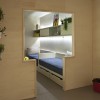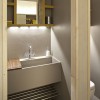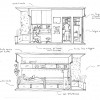Small Space Design Provides Escape Route for Italian Prisoners
While American prisons relegate their inmates to making jumpers and license plates, Italians are letting their design compact, multifunctional spaces. Educational group Cibic Workshop and design firm Comodo are exploiting their country’s prisoners’ have conceived a project dubbed FreedomRoom, which gives inmates of the Spoleto prison free reign to design and build a 116 sq ft living space–the same size as their prison cells–intended to further prison cell design, as well as bring prisoner wisdom for possible low cost hotels, student facilities and hostels. The sample module was on display at the recent Milan Design Week.
Apparently, there’s a big culture of DIY’ing and multifunctional design in Italian prisons as the FreedomRoom’s site explains:
[The team has] discovered that most of the items produced there [in the prison’s carpentry facility] become something else inside a prison cell. Space itself becomes something else. Living under restraint has led many inmates in Italian prisons, out of necessity, to reinvent the space in their cells as well as the way they use many of the items inside. That’s how Freedom Room project was born.
This customization might be a function of the depersonalization of the cell design, which is uniform between “men, women, minors, leaders of criminal gangs or the perpetrators of petty crimes and ‘white-collar’ criminals,” says prison director Lucia Castellano. She thinks FreedomRoom might be great way to bring life to system that is shut down literally and figuratively. She says:
Inmates can become the proponents of a new ‘culture’ in their day-to-day living environment, starting with the difficult situation they experience on a permanent basis and transforming it into a resource. The depersonalization typical of such institutions can be effectively addressed and the fear of critical [violent] events and liability may thus be abated.
There aren’t many remarkable design features of the sample module per se (we appreciate the requisite espresso maker), but the project itself is pretty remarkable. By giving credence to the intelligence of an otherwise disregarded population, FreedomRoom provides the opportunity to empower prisoners through design. It also gives un-incarcerated populations a great, low-cost model for space-saving design, direct from people who are very intimate with efficient use of small spaces.
Via designboom
images © Cibic Workshop









Pingback: Freedom Room: the book | CIBICWORKSHOP()
Pingback: Freedom Room | CIBICWORKSHOP()